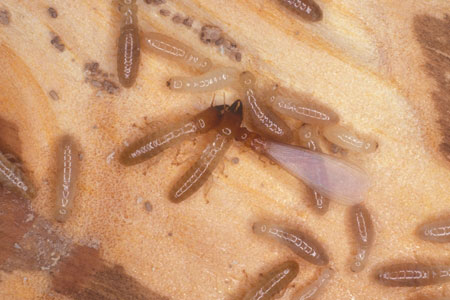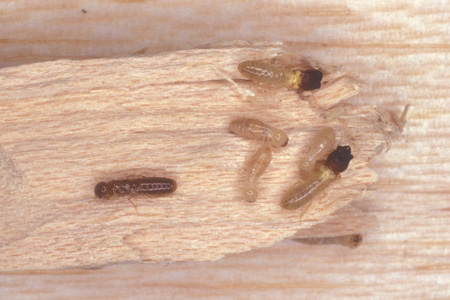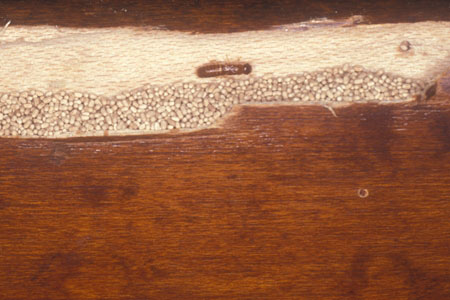Active Seasons


Drywood Termite Appearance and Size Facts
Drywood termites are social insects, as they live in colonies with an established caste system. While they may be small and like to stay out of sight, don’t underestimate them. Drywood termites (and termites in general) are among some of the most destructive pests you can find in your home or place of business.
Here are a few common traits of rice weevils:
- Soft rounded bodies. Drywood termites are usually cylinder-shaped with a straight waist, short legs, and two antennae.
- Small in size. These pests usually range from three-eighths to one-half inch long.
- Brownish cream color: These termites can be identified by their light-brown-to-tan bodies, however the workers are typically white or cream in color.
- Four wings: You’ll also notice that drywood termites have four equal-sized wings that extend longer than the body itself. This is how they got the infraorder name “Isoptera”, meaning equal wings.
Distinguishing Drywood Termites From Other Termites
Generally speaking, there are three groups of termites in South Florida: drywood, dampwood, and subterranean.
Drywood termites expel “frass” fecal pellets that are a sign of their presence. They infest dry wood without requiring soil contact. Subterranean termites use noticeable “mud tubes” to rely on soil moisture. Dampwood termites are larger, reddish-brown, and favor moist or wet wood.
We offer drywood termite treatment in the following locations and their surrounding areas:

Behavior and Habitat of Drywood Termites
In a colony of drywood termites, you will find a king, a queen, soldiers, nymphs, and workers. These populations thrive deep within the wood and don’t require a close connection to the ground for survival, as they get all the nutrients they need from their diet and prefer places like attics, door frames, window frames, baseboards, flooring, furniture, fascia boards, and other areas they can stay hidden. Colonies can contain up to 5,000 termites once matured.

Signs of Infestation of Drywood Termites
One of the top signs of drywood termites is the presence of frass, which are tiny, six-sided fecal pellets that often accumulate in small piles beneath kickout holes in infested wood. Drywood termites also create smooth and clean galleries within wood, so if you were to break open an infested piece of timber, you’d notice hollowed-out tunnels. Homeowners might also notice thin, papery wings shed by swarmers during their nuptial flights. These discarded wings, often found near window sills or lights, indicate that a colony may be looking to establish a new nest nearby. Drywood termite wings have three or more sclerotized veins with cross branching and are typically iridescent in color.

Tips for Prevention of Drywood Termites
The best way to prevent drywood termites in Florida is to regularly inspect and caulk the openings and cracks and crevices near entrances, windows, and other gaps and crevices of your home to make sure there are no easy paths of entry. The best drywood termite prevention is to consult with a professional pest control company to treat your attic space and prone areas.
Getting Rid of Drywood Termites
Since termites like to stay hidden and can deal significant damage before you’ve noticed their presence, there’s not a ton you can individually do to fight back. The best way to get rid of drywood termites in Florida is to invest in professional residential pest control or commercial pest control treatments. There are options for tented and no-tent treatments. Smaller-scale issues can be handled without tenting, while large termite infestations often require full fumigation. Speak with a Hulett professional to determine what’s best for your situation.
Effective Drywood Termite Control Solutions
Discovering a termite infestation can be quite stressful, and you often can’t determine the scope of the issue on your own. The best way to protect your home is to bring in the experts at Hulett Environmental Services. As one of the top 25 pest control companies in the United States, we’ve provided top-tier pest control services in south Florida for more than 50 years. Our friendly team of technicians is equipped to provide expert drywood termite treatments along with services for other common household pests.
Ready to take the first steps toward establishing a pest-free home environment? Schedule a free inspection or give us a call to learn more about Florida drywood termite control today!




